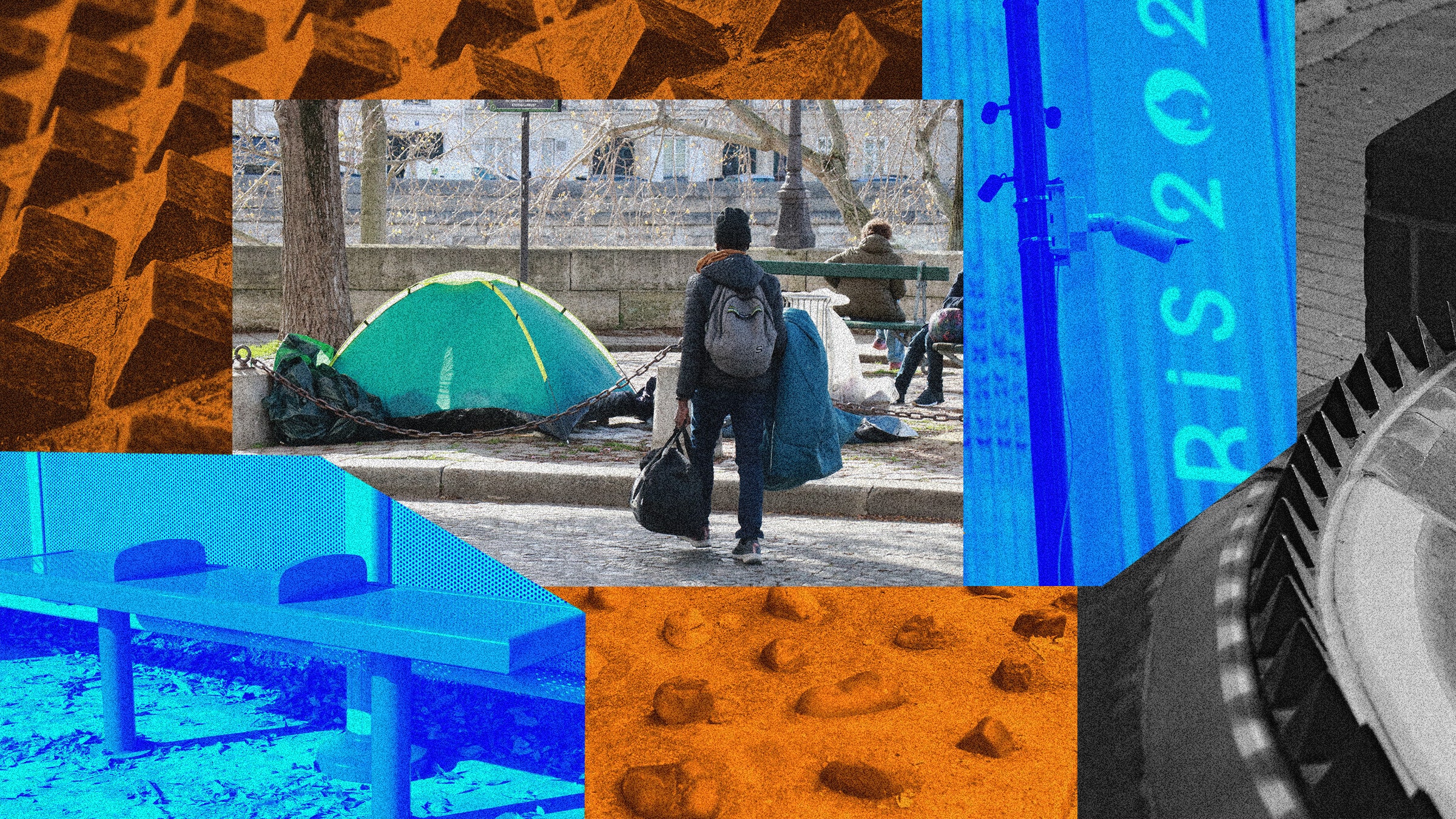
On a graffiti-stained sidewalk in Paris, a strange sight appeared days before the Olympic opening ceremony in July: Around 40 giant cement Lego-like blocks in neat rows beneath the Pont de Stains, a bridge in the northern suburb of Aubervilliers that connects two Olympic sites, the Stade de France and the Parc des Nations.
This place used to be a homeless encampment, where around 100 people, many of them migrants, lived in tents. Then on July 17, the police arrived and instructed everyone to leave, as part of a cleanup operation in which authorities put homeless people, members of the Roma community, migrants, and sex workers on buses to other cities, such as Bordeaux or Toulouse.
Once the authorities emptied the area, according to activists, the immovable blocks of concrete were installed in place of the tents, ending any notion the former residents may one day be able to return.
Campaigners say these bricks are an example of hostile architecture, a term used to describe some of the most visible changes cities and companies make to deter homeless people loitering or sleeping on their properties. “This is not new, but it has been intensified in a very specific way during the Olympics,” says Antoine de Clerck, part of Le Revers de la Médaille, a group of activists raising awareness of how marginalized people are treated during the Olympic Games.
“We do not advocate for encampments and squats and shantytowns,” adds de Clerck. “But to eradicate them, you have to find alternative long-term solutions.”
Despite other examples of hostile architecture in Paris, including picnic tables installed where people used to sleep, it is the giant Lego-style blocks that have proved most controversial. “I haven’t seen anything quite like this,” says Jules Boykoff, a professor and former professional soccer player who studies the impact of the Olympics on marginalized communities. “Typically, hostile architecture is more subtle,” he says, “like a curved bus bench that makes it less comfortable for somebody to sleep.”
Anti-homeless spikes and rough surfaces installed in a luxury housing complex to deter homeless people from sleeping in the area around the Limehouse Basin marina in London, UKPhotograph: Julio Etchart/ullstein bild via Getty Images
Boykoff says the Lego-like blocks are part of a wider trend he has witnessed in other Olympic host cities, such as London in 2012 and Rio de Janeiro in 2016. “This is part of the displacement and eviction of marginalized populations [that takes place] in the host city to ‘sanitize’ the space so that when journalists and writers, like myself, or Olympic tourists arrive, they aren’t confronted with the realities of dealing with poor people, basically.”
Once the ousted homeless people arrived in the south of France, they were given three weeks of alternative housing, says Samy Djemaoun, a French lawyer who helps homeless families petition the state for housing. Djemaoun adds that many people who were not eligible for residency or asylum ended up back on the streets. Neither the French interior minister nor the mayor of Aubervilliers replied to WIRED’s requests for comment.
“This system has been set up for the purpose of the Olympic Games,” Djemaoun says. “It’s the first time in the history of emergency housing that the state sends homeless people out of Paris.”
Homelessness in Europe has more than doubled over the past 15 years, to almost 900,000 people, according to FEANTSA, a European federation of organizations dedicated to the issue. Throughout that time, activists have repeatedly launched campaigns against hostile architecture, using hashtags like #HomesNotSpikes or #SoyonsHumains to document examples, from single-seater benches in Lyon to concrete bollards installed in doorways where people might be tempted to sleep. The subreddit r/HostileArchitecture has 147,000 often outraged members.
Spiked metal rail designed to stop people from laying down or sitting in front of a storePhotograph: OceanProd/Getty Images
“If you want to end homelessness, you really have to invest in policies that put people into accommodation, not just displace them from certain places,” says María José Aldanas, policy officer at FEANTSA.
In the US, hostile architecture has taken an even more dystopian turn. Cities like San Francisco have long used bollards or planters to prevent homeless people sleeping in certain places. Washington Post journalist Emily Rauhala recently went viral on X after she shared her experience waiting outside a Washington, DC, branch of the pharmacy chain CVS. She wrote that a nearby surveillance camera suddenly told her not to loiter.
CCTV surveillance camera in front of the Grand Palais Olympic site in Paris on July 22, 2024Photograph: EMMANUEL DUNAND/AFP via Getty Images
CVS spokesperson Amy Thibault tells WIRED that the company also uses this technology, made by a company called LiveView Technologies, in Houston, Dallas, Chicago, Phoenix, and San Diego. The cameras work by either broadcasting an automated announcement by loudspeaker or flashing strobe lights when suspicious activity is detected, according to LiveView Technologies chief technology officer Steve Lindsey.
CVS is also deploying this technology in Los Angeles, which will host the Summer Olympics in 2028. “If you want to understand what’s going to happen in Los Angeles in four years,” says Boykoff, “People in LA would do well to look at the machinations happening right here in Paris.”
Update 8/9/24 1:30pm ET: This story has been updated to reflect that the surveillance camera company’s name is LiveView Technologies, not LiveView.





